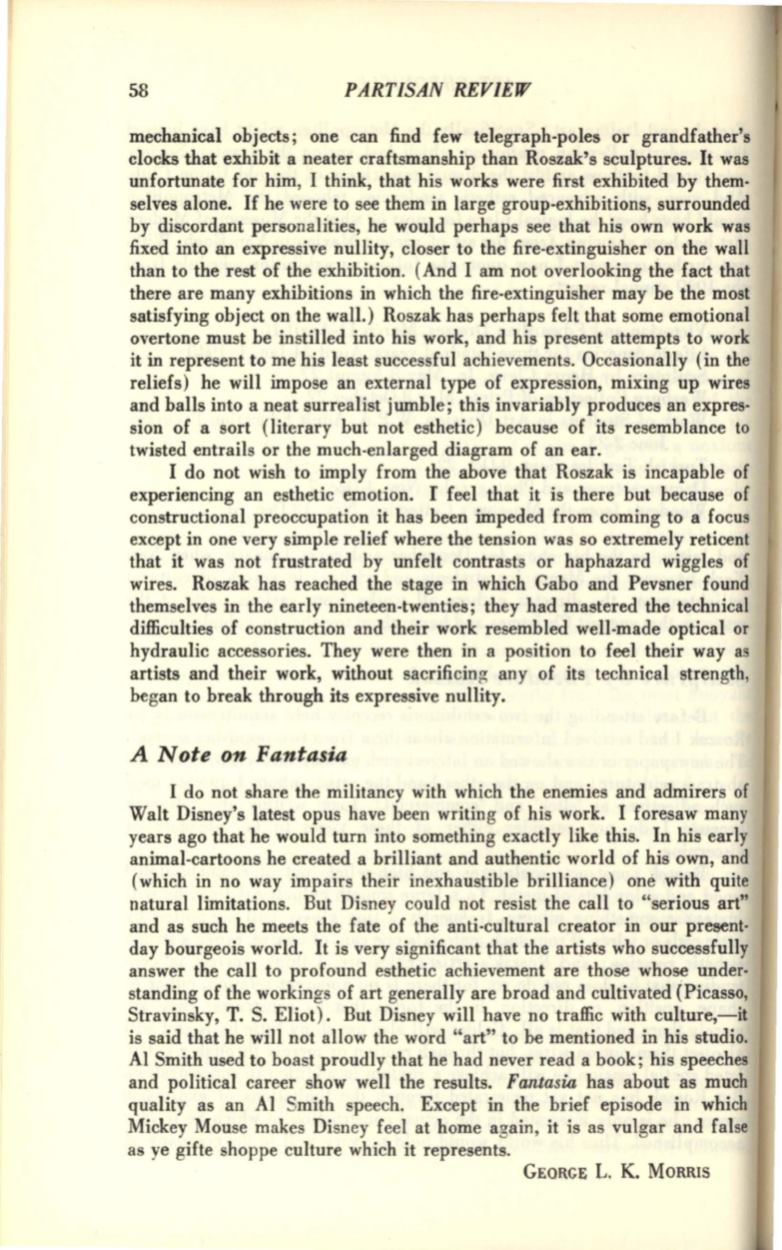
58
PARTISAN REVIEW
mechanical objects; one can find few telegraph-poles or grandfather's
clocks that exhibit a neater craftsmanship than Roszak's sculptures. It was
unfortunate for him, I think, that his works were first exhibited by them–
selves alone.
If
he were to see them in large group-exhibitions, surrounded
by discordant personalities, he would perhaps see that his own work was
fixed into an expressive nullity, closer to the fire-extinguisher on the wall
than to the rest of the exhibition. (And I am not overlooking the fact that
there are many exhibitions in which the fire-extinguisher may be the most
satisfying object on the wall.) Roszak has perhaps felt that some emotional
overtone must be instilled into his work, and his present attempts to work
it in represent to me his least successful achievements. Occasionally (in the
reliefs) he will impose an external type of expression, mixing up wires
and balls into a neat surrealist jumble; this invariably produces an expres·
sion of a sort (literary but not esthetic) because of its resemblance to
twisted entrails or the much-enlarged diagram of an ear.
I do not wish to imply from the above that Roszak is incapable of
experiencing an esthetic emotion. I feel that it is there but because of
constructional preoccupation it has been impeded from coming to a focus
except in one very simple relief where the tension was so extremely reticent
that it was not frustrated by unfelt contrasts or haphazard wiggles of
wires. Roszak has reached the stage in which Gabo and Pevsner found
themselves in the early nineteen-twenties; they had mastered the technical
difficulties of construction and their work resembled well-made optical or
hydraulic accessories. They were then in a position to feel their way as
artists and their work, without sacrificing any of its technical strength,
began to break through its expressive nullity.
A Note on Fantasia
I do not share the militancy with which the enemies and admirers of
Walt Disney's latest opus have been writing of his work. I foresaw many
years ago that he would turn into something exactly like this. In his early
animal-cartoons he created a brilliant and authentic world of his own, and
(which in no way impairs their inexhaustible brilliance) one with quite
natural limitations. But Disney could not resist the call to "serious art"
and as such he meets the fate of the anti-cultural creator in our present·
day bourgeois world. It is very significant that the artists who successfully
answer the call to profound esthetic achievement are those whose under·
standing of the workings of art generally are broad and cultivated {Picasso,
Stravinsky, T. S. Eliot). But Disney will have no traffic with culture,-it
is said that he will not allow the word "art" to be mentioned in his studio.
AI Smith used to boast proudly that he had never read a book; his speeches
and political career show well the results.
Fantasia
has about as much
quality as an AI Smith speech. Except in the brief episode in which
Mickey Mouse makes Disney feel at home again, it is as vulgar and false
as ye gifte shoppe culture which it represents.
GEORGE
L. K.
MORRIS


